



OF COURSE ALL mathematicians, as well as such as have a natural bent towards the principles of geometry, appreciate the perfection of the form of the circle as compared with all other shapes. The nearer an oblong, square or polygon approaches the form of a circle the greater will be the surface in proportion to the length of line required to enclose it. This proposition is well illustrated in the following problem which is given to show that the length of fence required to enclose a field gives no indication of the acreage.
It appears that two Hayseeds, who knew nothing about an acre of land containing 43,560 square feet, had been figuring out on the barn door a smart dicker which they concluded with Farmer Sykes’ boy, who was fresh from college.
They traded one large field for another, and believed that they got the best of the bargain because it took more rails to enclose the new field. Their old lot had 140 rails on one side by 150 on the other, which would make 580 rails on the four sides. The field for which they traded has 110 rails by 190, Which would make 500 rails on the four sides.
The dimensions of the two fields arc correctly shown on the barn doors and illustrate a valuable lesson in geometry pertaining to form and dimensions. To present one problem in tangible form, let the proposition be: Supposing that 840 squashes are raised to the acre. How many squashes will those smart Alecs lose on the year’s crop by trading fields? Or, in other words, how much does Farmer Sykes' boy's knowledge of elementary geometry profit him per year in this one little transaction, to say nothing about the thousands of opportunities which will occur during the year for him to turn his practical knowledge of mathematics to account?
In that Trading Lot puzzle as the same proportion of squashes as acres is lost the farmers lose 4 squashes per acre.
2.
Why, when you paint a man’s portrait, may you be described as stepping into his shoes? Because you make his feet yours (features).
Why may a beggar wear a very short coat? Because it will be long enough before he gets another.
Which is the most valuable, a five-dollar note or five gold dollars? The note, because when you put it in your pocket you double it, and when you take it out again you see it increases.
Why is a pretty young lady like a wagon wheel? Because she is surrounded by felloes (fellows).
What is the difference between form and ceremony? You sit upon one and stand on the other.
What is the most awkward time for a train to start? 12:50, as it’s ten to one if you catch it.
Why is a camel a very pugnacious animal? Because he always has his back up.
Why can the world be compared to music? Because it is so full of sharps and flats.
[Page 68]